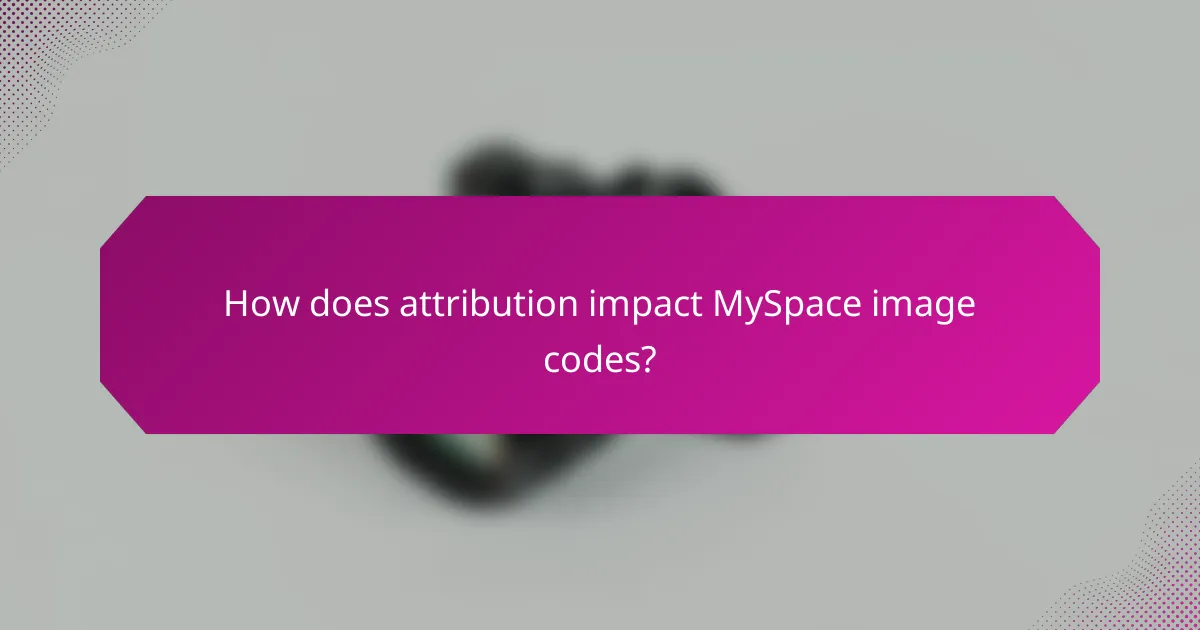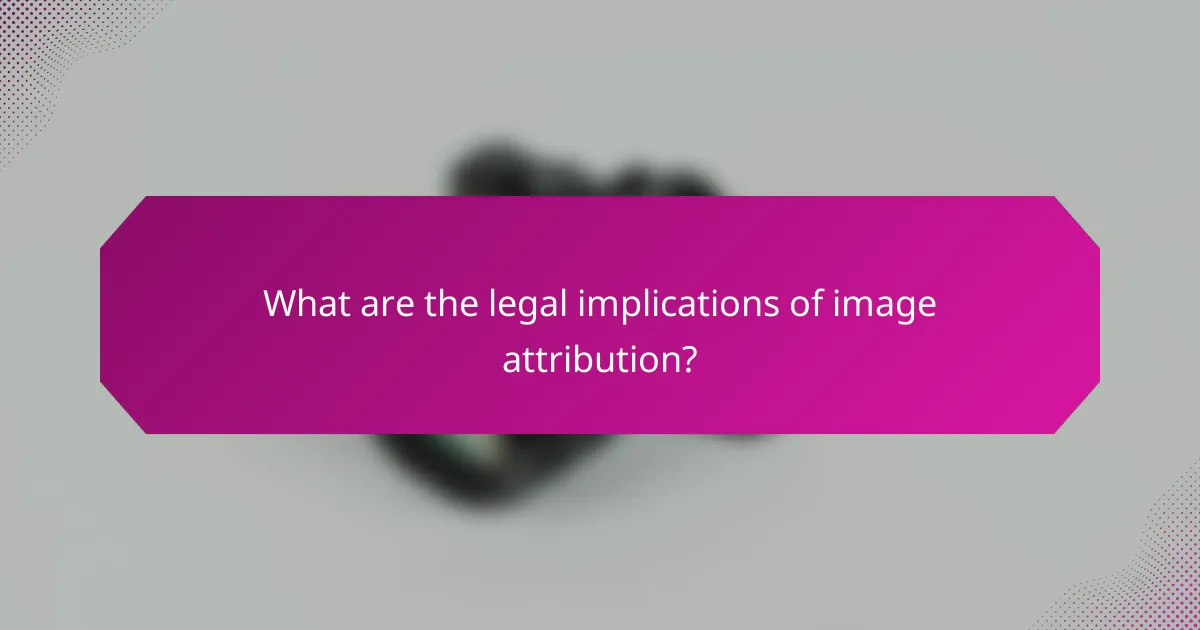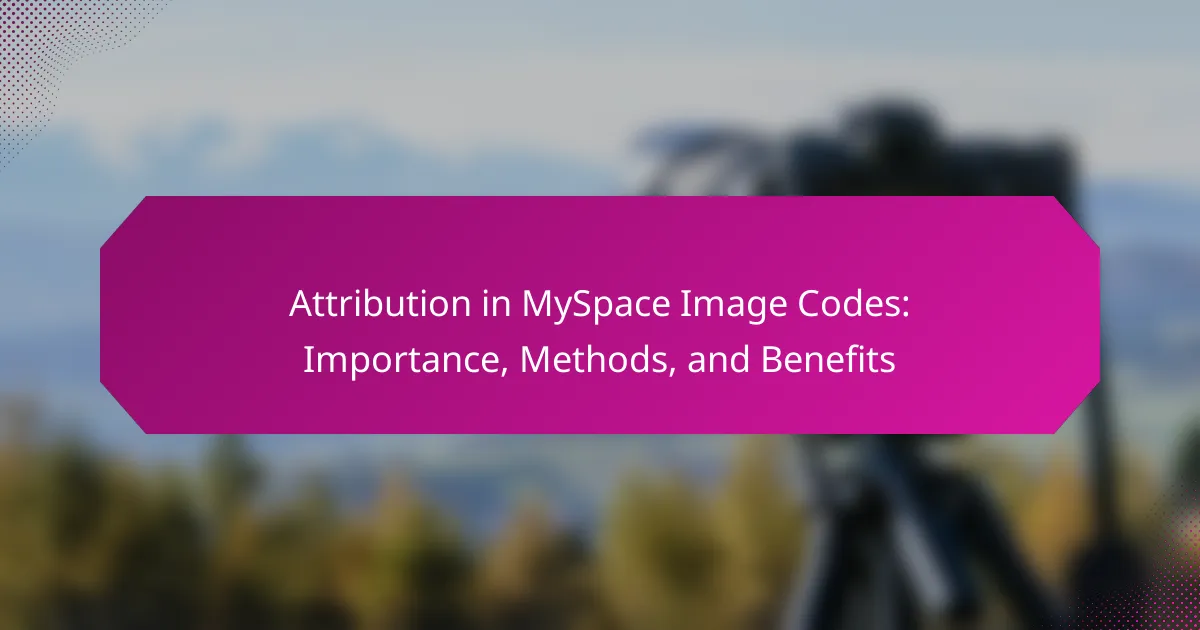Attribution in MySpace image codes is essential for recognizing the original creators of images, promoting ethical usage, and adhering to copyright laws. By implementing effective attribution methods, users not only enhance their profile’s credibility but also contribute to a respectful online community that values collaboration and creativity.

How does attribution impact MySpace image codes?
Attribution in MySpace image codes is crucial as it gives credit to the original creators of the images, ensuring ethical use and compliance with copyright laws. Proper attribution can enhance the visibility and credibility of your profile while protecting your rights as a content creator.
Enhances credibility
Including attribution in MySpace image codes significantly boosts your credibility. When users see that you credit original artists or photographers, they are more likely to trust your content and engage with your profile. This trust can translate into increased followers and interactions.
To enhance credibility, always use clear and accurate attribution formats. For example, including the creator’s name and a link to their portfolio can provide transparency and foster goodwill within the community.
Improves SEO performance
Attribution can positively affect your SEO performance on MySpace. Search engines favor content that respects copyright and provides proper credit, which can lead to better rankings in search results. This can ultimately drive more traffic to your profile.
To maximize SEO benefits, ensure that your image codes include relevant keywords in the alt text and descriptions alongside the attribution. This practice helps search engines understand your content better and improves discoverability.
Protects intellectual property
Attribution serves as a protective measure for intellectual property rights. By properly crediting image creators, you minimize the risk of copyright infringement claims against your profile. This practice not only safeguards your content but also respects the rights of others.
To protect your intellectual property, familiarize yourself with copyright laws relevant to your region. In many cases, including a simple credit line can prevent legal issues and foster a culture of respect within the MySpace community.

What methods can be used for attribution in MySpace image codes?
Attribution in MySpace image codes can be achieved through various methods that ensure proper credit is given to image creators. These methods include direct URL linking, image credits in captions, and using attribution tools, each offering unique advantages for users.
Direct URL linking
Direct URL linking involves embedding a clickable link within the image code that redirects viewers to the original source of the image. This method is straightforward and allows users to easily access the creator’s website or profile, enhancing visibility and traffic.
When using direct URL linking, ensure that the link is functional and leads to a reputable source. Avoid using shortened URLs, as they can obscure the destination and may be perceived as untrustworthy.
Image credits in captions
Including image credits in captions is another effective way to attribute images on MySpace. This method places the creator’s name or a link directly beneath the image, making it clear who produced the content.
When adding captions, keep them concise and relevant. For example, you might write “Photo by [Creator’s Name]” or “Image courtesy of [Website].” This not only gives credit but also adds context to the image.
Using attribution tools
Attribution tools can simplify the process of giving credit to image creators. These tools often generate the necessary code snippets that include proper attribution, ensuring compliance with copyright standards.
Popular attribution tools include platforms like Creative Commons and various online image repositories that provide ready-to-use codes. Always verify that the tool you choose aligns with the licensing requirements of the images you are using.

What are the benefits of proper attribution in MySpace?
Proper attribution in MySpace enhances credibility and fosters a respectful online community. By giving credit to original creators, users can build trust and encourage collaboration among artists and content creators.
Increases user trust
Attributing images correctly establishes transparency, which is crucial for building user trust. When creators see their work acknowledged, they are more likely to engage positively with the platform and its users.
For example, if a user shares a photo with proper attribution, it signals to others that they value the original creator’s rights. This practice can lead to a more supportive environment where users feel appreciated and respected.
Boosts engagement rates
Proper attribution can significantly boost engagement rates on MySpace. When users see that content is credited, they are more inclined to interact with it, whether through likes, shares, or comments.
Additionally, when creators are recognized, they may promote their work further, leading to increased visibility. This reciprocal relationship can enhance overall engagement on the platform, benefiting both users and creators alike.
Facilitates content sharing
Attribution simplifies the process of content sharing by providing clear ownership information. When users know who created a piece of content, they can easily share it while giving credit, which encourages a culture of sharing.
Moreover, platforms like MySpace often have built-in tools for sharing attributed content, making it easier for users to spread the word about their favorite creators. This not only amplifies the reach of the original content but also fosters community connections among users.

What are the best practices for image attribution on MySpace?
Best practices for image attribution on MySpace involve ensuring that all images used are properly credited to their original creators. This not only respects copyright laws but also enhances the credibility of your content.
Consistent formatting
Consistent formatting of image attributions helps maintain a professional appearance on your MySpace profile. Use a standard format for all attributions, such as including the creator’s name, the title of the work, and a link to the source if available. For example, you might format it as “Image by [Creator Name] from [Source Link].”
By keeping the format uniform, you make it easier for viewers to recognize and understand the attributions, which can improve user engagement.
Clear visibility
Attributions should be clearly visible to ensure that viewers can easily identify the source of the images. Place attributions close to the images they refer to, using a font size and color that contrasts well with the background. This prevents the attributions from being overlooked.
Avoid placing attributions in small text or in less prominent areas of your profile, as this can diminish their effectiveness and may lead to copyright issues.
Regular updates
Regularly updating your image attributions is crucial, especially if you change images or if the original sources have updated their links or terms of use. Make it a habit to review your profile periodically to ensure all attributions are current and accurate.
Additionally, if you notice any changes in copyright status or licensing for the images you use, update your attributions accordingly to remain compliant with legal requirements.

What are the legal implications of image attribution?
Image attribution carries significant legal implications, primarily related to copyright and licensing. Properly attributing images can help avoid legal disputes and ensure compliance with intellectual property laws.
Copyright compliance
Copyright compliance is crucial when using images, as unauthorized use can lead to legal repercussions. To comply, always check if the image is protected by copyright and whether you have permission to use it. This often involves attributing the creator according to the specified guidelines.
For example, if an image is licensed under Creative Commons, you must follow the specific attribution requirements, which may include the creator’s name, the title of the work, and a link to the license. Failing to do so can result in copyright infringement claims.
Licensing agreements
Licensing agreements outline how images can be used and the obligations of the user. These agreements can vary widely, from free-to-use licenses to those requiring payment for commercial use. Understanding the terms of a license is essential to avoid violating the agreement.
For instance, some licenses may allow personal use without attribution, while others require explicit credit even for non-commercial use. Always read the fine print to ensure compliance with the licensing terms.
Fair use considerations
Fair use is a legal doctrine that allows limited use of copyrighted material without permission under certain conditions. Factors that determine fair use include the purpose of use, the nature of the copyrighted work, the amount used, and the effect on the market value of the original work.
For example, using a small portion of an image for educational purposes may qualify as fair use, while using an entire image for commercial gain likely would not. It’s advisable to err on the side of caution and seek permission when in doubt about fair use applicability.
